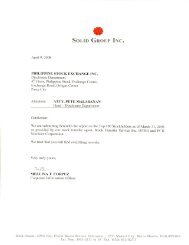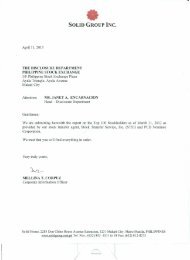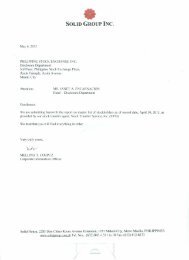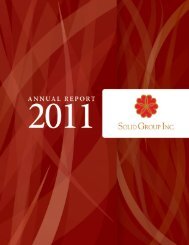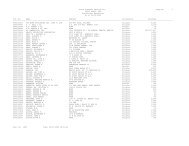SEC Form 17-A: Annual Report - the solid group inc website
SEC Form 17-A: Annual Report - the solid group inc website
SEC Form 17-A: Annual Report - the solid group inc website
Create successful ePaper yourself
Turn your PDF publications into a flip-book with our unique Google optimized e-Paper software.
- 26 -<br />
Current tax assets or liabilities comprise those claims from, or obligations to, fiscal<br />
authorities relating to <strong>the</strong> current or prior reporting period, that are uncollected or<br />
unpaid at <strong>the</strong> reporting period. They are calculated using <strong>the</strong> tax rates and tax laws<br />
applicable to <strong>the</strong> fiscal periods to which <strong>the</strong>y relate, based on <strong>the</strong> taxable profit for <strong>the</strong><br />
year. All changes to current tax assets or liabilities are recognized as a component of tax<br />
expense in <strong>the</strong> con<strong>solid</strong>ated statement of <strong>inc</strong>ome.<br />
Deferred tax is provided, using <strong>the</strong> liability method on temporary differences, at <strong>the</strong> end<br />
of <strong>the</strong> reporting period between <strong>the</strong> tax base of assets and liabilities and <strong>the</strong>ir carrying<br />
amounts for financial reporting purposes. Under <strong>the</strong> liability method, with certain<br />
exceptions, deferred tax liabilities are recognized for all taxable temporary differences<br />
and deferred tax assets are recognized for all deductible temporary differences and <strong>the</strong><br />
carryforward of unused tax losses and unused tax credits to <strong>the</strong> extent that it is probable<br />
that taxable profit will be available against which <strong>the</strong> deductible temporary difference<br />
can be utilized. Unrecognized deferred tax assets are reassessed at <strong>the</strong> end of each<br />
reporting period and are recognized to <strong>the</strong> extent that it has become probable that<br />
future taxable profit will be available to allow such deferred tax assets to be recovered.<br />
The carrying amount of deferred tax assets is reviewed at <strong>the</strong> end of each reporting<br />
period and reduced to <strong>the</strong> extent that it is probable that sufficient taxable profit will be<br />
available to allow all or part of <strong>the</strong> deferred tax asset to be utilized.<br />
Deferred tax assets and liabilities are measured at <strong>the</strong> tax rates that are expected to apply<br />
to <strong>the</strong> period when <strong>the</strong> asset is realized or <strong>the</strong> liability is settled provided such tax rates<br />
have been enacted or substantively enacted at <strong>the</strong> end of <strong>the</strong> reporting period.<br />
Most changes in deferred tax assets or liabilities are recognized as a component of tax<br />
expense in profit or loss. Only changes in deferred tax assets or liabilities that relate to<br />
items recognized in o<strong>the</strong>r comprehensive <strong>inc</strong>ome or directly in equity are recognized in<br />
o<strong>the</strong>r comprehensive <strong>inc</strong>ome or directly in equity.<br />
Deferred tax assets and deferred tax liabilities are offset if <strong>the</strong> Group has a legally<br />
enforceable right to set-off current tax assets against current tax liabilities and <strong>the</strong><br />
deferred taxes relate to <strong>the</strong> same entity and <strong>the</strong> same taxation authority.<br />
2.22 Related Party Transactions and Relationships<br />
Related party transactions are transfers of resources, services or obligations between <strong>the</strong><br />
Group and its related parties, regardless whe<strong>the</strong>r a price is charged.<br />
Parties are considered to be related if one party has <strong>the</strong> ability to control <strong>the</strong> o<strong>the</strong>r party<br />
or exercise significant influence over <strong>the</strong> o<strong>the</strong>r party in making financial and operating<br />
decisions. These parties <strong>inc</strong>lude: (a) individuals owning, directly or indirectly through<br />
one or more intermediaries, control or are controlled by, or under common control<br />
with <strong>the</strong> Group, (b) associates; and, (c) individuals owning directly or indirectly, an<br />
interest in <strong>the</strong> voting power of <strong>the</strong> Group that gives <strong>the</strong>m significant influence over <strong>the</strong><br />
Group and close members of <strong>the</strong> family of any such individual. In considering each<br />
possible related party relationship, attention is directed to <strong>the</strong> substance of <strong>the</strong><br />
relationship and not merely on <strong>the</strong> legal form.



